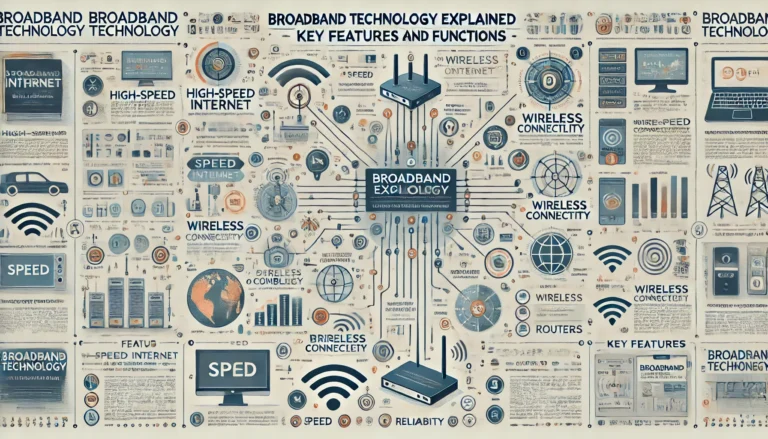Broadband Networks: A Detailed Look at the Key Components
Table Of Contents
Broadband Networks: A Detailed Look At The Key Components | Exploring Broadband Networks: An In-Depth Analysis of Key Components
Key Takeaways
- Significant Aspects of Broadband Networks
- In-Depth Analysis of Network Components
- Navigating Intelligent Network Structures
- Detailed Examination of Key Components
Broadband Networks: Exploring the Significant Elements
Broadband networks play a pivotal role in today’s interconnected world. Understanding the essence of broadband connections and the various technologies powering them is crucial. From fixed broadband to national broadband networks, the components constituting these systems form the backbone of our digital infrastructure. Delving into the intricate details of broadband networks unveils the interplay and functionality among broadband technologies, access providers, and policies. To truly appreciate the significance of broadband networks, one must grasp the diverse types of broadband connections available and how they contribute to fostering efficient and meaningful broadband access for individuals and businesses alike. Broadband networks: A detailed look at the key components sheds light on the complexity and importance of these modern-day networks.
- Broadband connections serve as the foundation for internet access for both individuals and businesses
- Different broadband technologies include DSL, cable, fiber-optic, satellite, and wireless connections
- Access providers such as ISPs and telecommunication companies are instrumental in delivering broadband services to end-users
- Policies related to broadband networks, such as net neutrality and spectrum allocation, influence the accessibility and quality of broadband services
- National broadband networks aim to provide high-speed internet access to all citizens, bridging the digital divide
Understanding Broadband Networks: Their Role and Importance
Broadband networks have become an integral part of our daily lives, powering the internet connectivity that we rely on for communication and information access. These networks play a crucial role in modern telecommunications networks and computer networks, providing high-speed broadband to users through a sophisticated network infrastructure. The broadband cables, broadband modems, and broadband network gateways are key components that ensure the efficient functioning of broadband networks, enabling the seamless flow of data and information.
In the United States, broadband mapping is essential for understanding the coverage and reach of broadband networks across the country. Initiatives like the National Broadband Plan and the Broadband Forum have been instrumental in driving the expansion of next-generation broadband services and improving broadband speed for users. From broadband ISDN to mobile broadband, the evolution of broadband networks has been marked by advancements in technology and an increasing focus on enhancing connectivity for all. Broadband networks continue to shape the way we communicate and access information, making them a critical aspect of our interconnected world.
Deconstructing Broadband Network’s Core Structures
Broadband networks are intricate systems composed of various key components that work together to ensure seamless connectivity. From cable networks to wireless infrastructure, these components form the backbone of telecommunications networks, providing the necessary bandwidth for data transmission. Core networks, digital networks, and internet backbones all play vital roles in the network architecture, facilitating the flow of information across computer networks efficiently. Wireless connectivity is essential in today’s digital landscape, enabling fast and reliable wireless connections for users across different devices and locations.
In understanding the core structures of broadband networks, it becomes evident that the interplay between these key components is crucial for the network’s functionality. Data networks rely on the intricate design of telecommunication networks to ensure smooth operations and maintain high bandwidth capabilities. By deconstructing the core structures of broadband networks, we gain insight into the complexity and sophistication required to sustain reliable and robust network infrastructures that power our modern digital world. Broadband networks: A detailed look at the key components reveals the intricate web of technologies that work together harmoniously to deliver fast and efficient connectivity to users worldwide.
A Comprehensive Study on Broadband Network Components
Broadband networks are the backbone of the internet, providing efficient internet connection worldwide. In this section, we will delve into broadband networks: a detailed look at the key components that form the crucial infrastructure of modern digital communications. Integrated broadband networks amalgamate traditional and intelligent broadband aspects to enhance broadband networking. By understanding broadband systems thoroughly, we can grasp the vast capabilities of broadband networking and its critical role in our digital era. Broadband mapping plays a pivotal role in optimizing broadband network solutions by identifying many broadband access points. By exploring broadband network components, we uncover the intricate interplay and functionality that drive the success of broadband networks.
Importance of Key Components: Fostering Efficient Broadband Networks
Broadband networks play a crucial role in today’s digital landscape, offering a diverse range of services to users. Understanding the broadband basics is essential to grasp the significance of key components that foster efficient broadband networks. From wired broadband infrastructure to broadband access technologies, various elements come together to enhance the broadband experience. Broadband standards and broadband user network specifications ensure that pilot broadband networks can deliver reliable and high-speed connections to users. Moreover, fixed access broadband, such as FTTH broadband connections, contributes to improving broadband capacity and performance data.
Delving deeper into the broadband variant, it becomes evident that the interplay of broadband services and broadband medium specifications is vital for optimal network performance. The broadband signal quality is a key component that influences the overall efficiency of broadband networks. By adhering to broadband standards and incorporating cutting-edge technologies, providers can offer seamless broadband experiences to users. The evolution of broadband networks has paved the way for enhanced broadband services and faster connectivity, making it imperative to continuously innovate and adapt to meet the growing demands of users.
Evolution and Progress of Broadband Network Components
Evolution and progress in broadband networks have been propelled by the constant drive to enhance connectivity and efficiency. A detailed look at the key components reveals the integral role they play in shaping the landscape of broadband communications. From the broadband edge segment to common network components, the evolution of broadband networks has paved the way for universal broadband access and next-generation broadband standards. With integrated broadband communications and continuous broadband sources, the industry has seen a shift towards effective broadband policy and the push for home broadband connections.
Broadband networks have witnessed significant advancements in recent years, particularly in the realm of FTTH broadband and many state broadband initiatives. The emphasis on the broadband edge and the importance of home broadband connections have underscored the need for robust and scalable network components. As the industry moves towards universal broadband access, the integration of various components is crucial in meeting the demand for high-speed connectivity. By adhering to next-generation broadband standards and fostering seamless broadband service, the evolution and progress of broadband networks continue to shape the digital landscape.
Navigating Through Intelligent Broadband Networks
Intelligent broadband networks have revolutionized the way we experience connectivity in the modern era. With a focus on creating robust network infrastructure, these networks have paved the way for new broadband services and ultra-shallow broadband deployments. The integration of mobile broadband technologies and broadband edge designs has significantly enhanced broadband data transfer speeds, enabling super-fast broadband experiences for users. By delving into the individual network components, such as DSL broadband and broadband video services, intelligent networks have streamlined the u.s. broadband deployment process and improved broadband user share. The multiservice broadband network architecture, coupled with well-designed core network components, ensures efficient broadband offices and seamless broadband services. The future of broadband networks lies in the continuous innovation and optimization of ultra-shallow broadband technologies to meet the evolving demands of the digital age.
The Rise of Intelligent Broadband Networks: A New Era
The era of intelligent broadband networks marks a significant shift in the landscape of connectivity. With a focus on enhancing internet infrastructure, these networks are designed to facilitate seamless broadband data transfer and support a wide range of broadband multimedia services. By addressing the limitations of subpar network infrastructure, intelligent broadband networks pave the way for robust and efficient connectivity solutions. The integration of modern network infrastructure ensures the delivery of future broadband multimedia services and enables the scalability required for the ever-expanding demands on connectivity. As interconnected networks—each playing a vital role in the network tier—form the backbone of these systems, the emphasis on scalable network infrastructure and installed bandwidths becomes crucial in meeting the evolving needs of users.
In a world where connectivity is paramount, the advent of intelligent broadband networks heralds a new era of integrated networks. By leveraging advanced networking infrastructure, these networks provide the necessary connectivity for a myriad of network devices and services. The seamless integration of broadband expansion page and the optimization of networking infrastructure ensure that users experience reliable and high-speed internet connections. As the demand for connectivity grows, the focus on scalable network infrastructure and the efficient management of installed bandwidths become instrumental in supporting the proliferation of network devices and services. The interconnected nature of these networks fosters a cohesive ecosystem that not only enhances connectivity but also sets the stage for the future of broadband networks: a comprehensive and efficient network that caters to the diverse needs of users.
| Network Feature | Description | Benefits |
|---|---|---|
| Scalable Infrastructure | An adaptable network design that can grow with demand. | Supports increased users and devices without compromising speed. |
| Advanced Bandwidth Management | Real-time optimization and allocation of bandwidth resources. | Improves overall network efficiency and user experience. |
| Interconnected Networks | Networks that work collaboratively to improve connectivity. | Enhances reliability and reduces latency across services. |
| Multimedia Service Support | Ability to handle various types of traffic, including video and IoT. | Enables seamless streaming and smart device connectivity. |
Significance of Intelligent Broadband Networks in Modern Times
Significance of Intelligent Broadband Networks in Modern Times
Intelligent broadband networks play a pivotal role in the modern telecommunications network by providing ample bandwidth for wide-bandwidth data transmission. When looking at Broadband Networks: A Detailed Look at the Key Components, it is evident that high bandwidth and reliable network infrastructure are indispensable for efficient network architectures. In modern networks, access networks like local cable networks serve as the broadband medium attachment, creating an ideal telecommunication network. Network infrastructure refers to the network monitoring tools that enable effective telecommunication networking, ensuring seamless operations and optimal performance across various related network metrics.
In the realm of intelligent broadband networks, the emphasis lies on the seamless integration of advanced technologies to facilitate high-speed data transmission and efficient network management. With a focus on Broadband Networks: A Detailed Look at the Key Components, the evolution of network architectures has led to the development of smarter and more dynamic network structures. By leveraging advanced network monitoring tools, modern networks—each designed for enhanced performance—can support the increasing demands for wide-bandwidth data transmission. Additionally, the adaptability and scalability of intelligent broadband networks ensure that they can cater to the evolving needs of a dynamic digital landscape, making them indispensable in modern times.
Role of Various Components in a Broadband Network
Understanding the role of various components in Broadband Networks is crucial for ensuring efficient and seamless connectivity services. A detailed look at the key components reveals that high bandwidth requirements are a key aspect in meeting the full bandwidth demands of users. In this context, fiber-optic broadband plays a vital role in providing superfast FTTH broadband, enabling direct connections and separate network infrastructure for local networking. The network infrastructure stack must be designed to support scalable network functions and optimize bandwidth capacity to meet the evolving needs of users.
In the realm of Broadband Networks, the interplay of network technology points to the significance of optical networks in enhancing connectivity services. Leveraging optical networks allows for the establishment of direct connections and high-speed data transmission, essential for a seamless broadband experience. By incorporating separate network infrastructure for optical networks, Broadband Networks can efficiently meet the connectivity demands of users while maintaining a robust and reliable network for various applications.
Interplay and Functionality of Broadband Network Components
Broadband Networks: A Detailed Look at the Key Components reveals the intricate web of connections that underpin our modern internet functions. From telephony networks to public networks, each component plays a crucial role in shaping our national bandwidth potential and global telecommunication capacity. The evolution of different network layers within a Broadband Networks reference architecture has paved the way for faster internet speeds and access connection to external networks, highlighting the necessity of sufficient bandwidth in today’s digital landscape.
In examining the interplay and functionality of Broadband Network Components, it becomes evident that the integration of ftth networks, including ftth network technology, has revolutionized telecommunications systems. The dynamic nature of multiple network structures allows for seamless interactions between various components, enhancing the performance of telephony networks and public networks. The role of telecommunications commissions in regulating and optimizing Broadband Networks underscores the importance of cohesive network management for maintaining efficient connections and supporting diverse internet functions.
Conclusion
Broadband Networks: A Detailed Look at the Key Components offers a comprehensive understanding of the intricate network structures that underpin the connectivity of different networks. From local networking schemes to advanced telecommunications access technologies, each component plays a vital role in enabling users to connect seamlessly. Whether it be cable internet services, satellite networks, or a single network that simplifies network design, the interplay of these elements is crucial in ensuring the efficiency and reliability of broadband networks in today’s digital landscape.
FAQS
What are the main components of broadband networks?
Broadband networks consist of various key components such as broadband providers, broadband internet access, traditional broadband networks, digital broadband networks, effective network infrastructure, network data, network capacity, and networking devices. These components work together to ensure the provision of high-speed internet services to users on a vast network.
What is the significance of broadband mapping in the United States?
Broadband mapping in the United States plays a crucial role in understanding and improving the country’s broadband network capability. By mapping out broadband coverage, providers and policymakers can identify gaps in broadband access, pinpoint areas that need improvement, and allocate resources effectively to enhance broadband programs and performance data. This information helps in creating a well-designed network infrastructure that ensures all citizens have access to super fast broadband with enough bandwidth to access the internet seamlessly.
What are the key components involved in a broadband communications network reference architecture?
A broadband communications network reference architecture involves several key components such as broadband integrated services digital network (B-ISDN), points of broadband, broadband performance data, wired infrastructure, total bandwidth, access to the internet, a common core network, FTTH network inclusion, and telecommunications access technology. This robust infrastructure incorporates various elements to ensure efficient connectivity and high-speed internet access for users.
What are the key points to consider when examining the components of broadband networks in detail?
When taking a detailed look at broadband networks, it’s important to understand the main components involved. These include various points such as broadband data improvement, access to the internet, the main network infrastructure, and the integration of many computer networks. Additionally, components like internet cables and fiber-to-the-home (FTTH) networks are all part of the intricate setup that enables broadband connectivity.
What points should be considered when examining the components of broadband networks in detail?
When examining the components of broadband networks in detail, it is essential to look at various key aspects. Broadband networks encompass a range of technologies and structures that facilitate high-speed internet access. Some points to consider include the different methods of access to the internet—cables, fiber optics, satellite, or wireless connections. Additionally, understanding the components of a broadband network reference architecture can shed light on how data is transmitted efficiently across the network. Technologies like FTTH (Fiber to the Home) networks include routers, switches, and other hardware that enable users to access the internet seamlessly. By delving into these components, one can gain a comprehensive understanding of the intricate systems that make up broadband networks.
What points should be considered when reviewing the key components of broadband networks in detail?
When examining the key components of broadband networks in detail, it is essential to consider various factors such as the points broadband networks, broadband words used, access to the internet, and the components of an FTTH network include. By focusing on these aspects, you can gain a comprehensive understanding of the infrastructure and technologies that make up broadband networks.
What access internet considerations should one keep in mind when analyzing broadband networks in detail?
When examining broadband networks in detail, it is crucial to consider key access internet components such as the type of technology used, network coverage, speed capabilities, reliability, security features, and the possibility of network congestion. These factors play a significant role in determining the overall performance and user experience of the broadband network.
What does a detailed examination of the key components of broadband networks entail?
When delving into a detailed look at the key components of broadband networks, it is essential to analyze elements such as network infrastructure, data transmission technologies, network architecture, network protocols, and network security measures. Each of these components plays a crucial role in ensuring the efficiency, reliability, and security of broadband networks.
What aspects should be explored when conducting a detailed analysis of broadband networks and their key components?
When delving into a thorough examination of broadband networks and their key components, it is essential to consider various aspects such as network infrastructure, transmission technologies, network protocols, and security measures. This detailed look allows for a better understanding of how broadband networks function and how they can be optimized for performance and reliability.
What aspects should be explored when conducting a detailed analysis of broadband networks and their key components in the article “Broadband Networks: A Detailed Look at the Key Components”?
In the article “Broadband Networks: A Detailed Look at the Key Components,” it is important to delve into various components such as network infrastructure, data transmission, bandwidth capacity, and network protocols to gain a comprehensive understanding of broadband networks. This analysis provides insights into how these components interact to enable high-speed and efficient internet connectivity for users.







